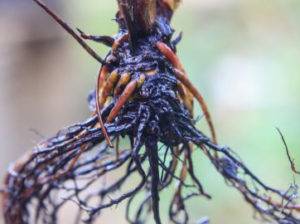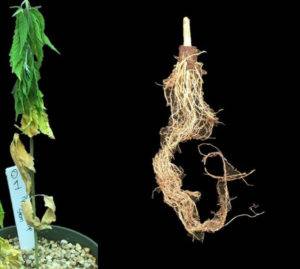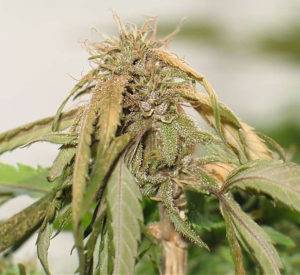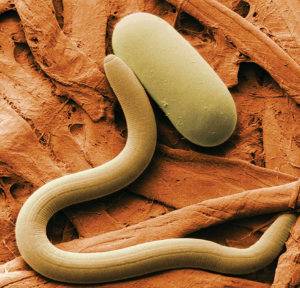Hemp Root Diseases
Last month, I wrote about common diseases that can attack the flower, stems, and leaves of hemp plants. This month, I want to dig a little deeper – literally underground – and look at some of the diseases that can go after hemp root systems. While our coverage of hemp pathogens is not meant to be all inclusive (that would take a book!) we hope to give you some insight on some of the most common ones so you can get a step ahead of them.

Know your enemy!
Per the previous blog, we know that disease instance can vary from location to location. That’s because environmental factors (humidity, average temperatures, elevation, and stress) are different from region to region. Any one of these factors has the ability to open the door and lay groundwork for pathogens to thrive. Understanding which fungi, bacteria, viruses, and nematodes are most prevalent in your area can be as simple as a visit with your local extension office and conversations with fellow growers. Forewarned is forearmed, as they say! Having this knowledge is key to quickly remediating disease at the first sign or, better yet, take preventive measures to thwart problems before they happen.

Root Rot
This nasty infection attacks the roots of your plants and blocks them from taking in needed nutrients. Most often, root rot is a symptom of poor soil texture. Temperatures can also play a role if they are extreme. Too warm and bacteria will breed; too cold and wilting may lead to root rot. Overwatering is also a possible culprit. When roots are literally drowning in too much water, they will suffocate for lack of oxygen and rot away. This all shows up as spotty leaves with curled edges and discoloration. It can also appear as stunted growth. The roots themselves will be brown, smelly, and slimy. Prevention is all about providing a healthy growing medium; soil should be friable and well drained. Carefully monitor your hydration and rain fall to ensure that plants are adequately – but not overly – watered. If you discover root rot in your plants before they are too far gone, there is a chance for recovery by lifting the affected plant and dipping the roots in a mixture of one liter of water plus 100 ml of bleach or hydrogen peroxide before replanting. No guarantees, but it’s worth a shot if it looks like you’re losing the plant anyway.

Pythium Root Rot
Though it’s not technically a fungus, pythium has some similar characteristics. It can be very destructive. As with several pathogens, excess water can drive infection. Stress factors that weaken your plants such as compacted, poorly drained soil and cool weather can also contribute to the growing conditions favored by pythium. It’s especially common during the germination stage but can go after mature plants as well. It will move through the canopy like a wildfire, killing everything in its path. If the reservoir temperature is over 75F in your flood and drain system you can breed pythium in your tank and then it will be everywhere. Chillers are necessary, expecially in the southern US, e.g. Florida. Look for weak stems, yellowed leaves, wilting, and collapsed plants. Treating a pythium outbreak can be costly. The options are over the counter, premium-priced root rot treatment chemicals or pulling out and discarding diseased plants. A far better choice is prevention. Make sure that you follow stringent sanitation practices when you are starting seeds and planting seedlings and, of course, take all the pre-planting steps you need to follow to assure that your soil is in optimal condition. You might want to re-read my early blogs on Soil Basics and Spring Soil Preparation that provide lots of great tips for you!

Fusarium
Also known as fusarium wilt, this is a nasty, fast-growing fungus that you want to aggressively avoid since it is especially hard to eradicate and can live for many years in the ground. There are different types of fusarium fungi, including the one that attacks the roots causing all the usual visual symptoms: stressed looking plants with yellowing leaves and brown stems. The affected areas eventually dry out. At this point, your only option is to save surrounding plants by removing diseased ones as quickly as possible. There are several different options to avoid this scenario. Always follow best practices for sanitation. This is sound advice for preventing a lot of pathogenic enemies and should be fundamental and consistent in your operation. Removing old, dead plant material after harvest stops remaining
spores from finding a home in the leftover debris. Use anti-stress products to encourage plant vigor and disease resistance. Trichoderma is a natural enemy of fusarium and one of the most efficient preventive measures you can apply. Just don’t use it with fungicides or chemical products which will kill off the beneficial fungus before it can do its work. The benefits of Trichoderma extend beyond its fusarium-zapping powers. It can help stimulate root growth, helps break down organic material, produces fungus-fighting antibiotics, and it’s eco friendly.

Nematodes
These little worm-like critters can attack hemp roots. We don’t have lots of information on nematode infestations of hemp, simply because they’ve haven’t been widely studied to date. Though there are many species with differing characteristics, typical nematodes will show up as little white galls throughout the root system. Those galls are home to a female which lays hundreds of eggs while literally sucking the life out of your plant. Like other pathogens, you’ll see wilting and slow growth, which may lead you to think your plants are short on a nutrient or have some kind of hydration issue. Making surethat your soil is well drained, your weed growth is managed, and plants are properly spaced in their rows will help reduce the likelihood you’ll have to deal with nematodes. An infestation can be treated
with insecticides, which may also help control other pests. There are also some natural products like beneficial bacteria, certain mushroom species, or Verticillium.
Preventing pathogenic problems is MUCH better than trying to treat them!
If some of these descriptions sounded a little repetitive – good! That means you noticed that a lot of the preventive measures are the same from one to the next: optimal soil, correct levels of hydration, proper weed management and plant spacing, and strengthening plants with nutrients and supplemental treatments. Even before you take these steps, make sure that you are purchasing seed from a quality
supplier known to have stringent cultivation practices and proven disease-resistant strains. Crop rotation is another way to break a pathogenic cycle or outbreak in your grow. Your extension service and other local growers might have suggestions for good rotation crops for your area. Sanitary practices are also critical. Tools, substrates, containers, and implements should be clean. It’s even a good idea to don clean clothes before walking in or working your rows; plenty of pathogens are capable of clinging to fabric you’re wearing and from there, it’s an easy transfer to your sensitive hemp plants. Pathogens seek out wounds in plants, so move carefully and gently through your grow to avoid damage to the plants.
Finally, take time to clean your rows out well after harvest by removing or burning dead organic material. Battling a pathogen once it is present can be expensive. It can cost you revenue from lost plants and it can cost you money when you have to outlay for pricey remedies. Sadly, even after expenditures, your treatment efforts may be too late. Our advice is to get ahead of the problem and make sure you’re doing all that you can to avoid these challenges in the first place!


Recent Comments